Supporters' Club Badges Over the Years
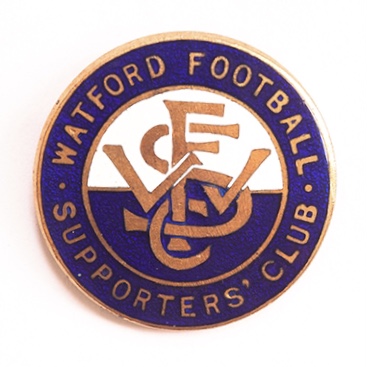

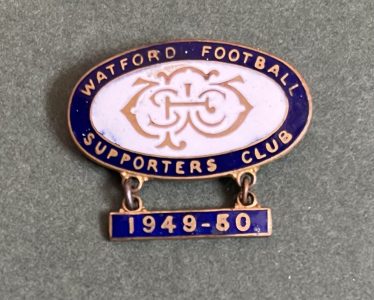
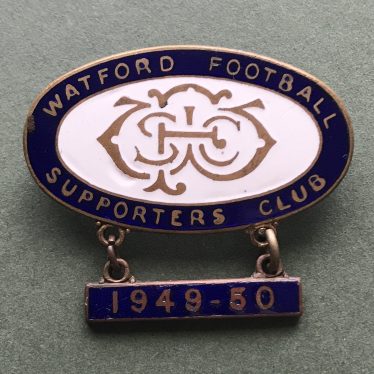
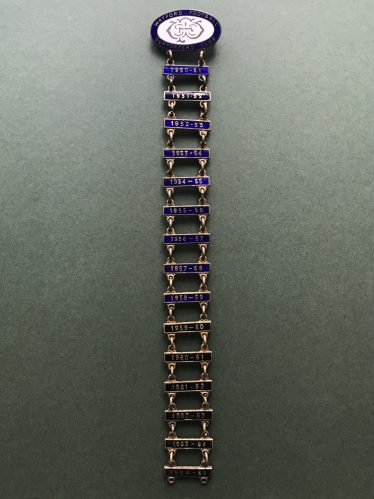






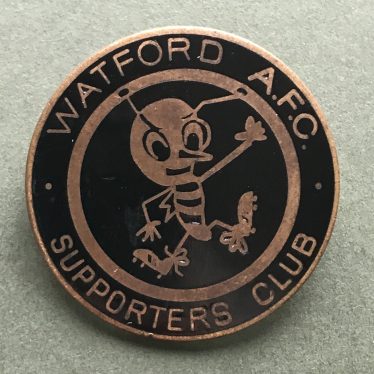



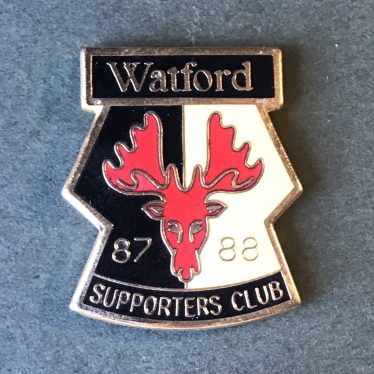


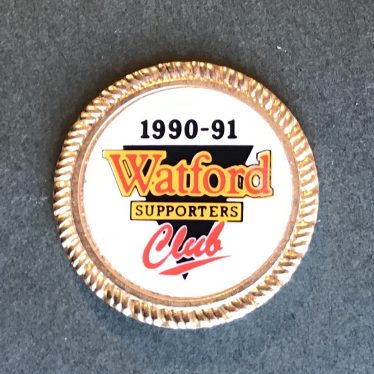

Long before the days of a club shop selling a wide variety of memorabilia, there had been very little that a supporter could buy in order to show their allegiance to The Wasps, The Magpies, The Brewers, The Blues or, later, The Hornets.
Amongst the first items made available specifically for supporters was an enamel pin badge issued by the WFSC in the late 1920s. The Watford Observer’s annual Football Handbook for the 1928-29 season exhorted fans to “become a member to-day and wear the Supporters Club badge”. Details of what this badge looked like remain obscure owing to its rarity; evidence suggests it may have been a blue-and-white enamelled, circular bronze pin badge displaying ‘WFSC’ in ornate lettering. The badge was issued to members, together with a fixture card, in return for their subscription which costed 1/- for the season.
For the rest of its existence, the Watford Football Supporters Club regularly advertised new issues of their pin badge on a dedicated page within match programmes and annual handbooks (the 1930-31 edition of the Handbook, for instance, describes a “newly-designed badge”).
In 1947-48, the Handbook advertised a new design of badge costing 3d. This was only made for this season and is a small and simple, yet attractive, circular tin badge.
This design gave way the following season (1948-49), to “new metal badges, with year bar attached, one shilling and ninepence each”; this seven-fold price rise reflected the move away from the relatively cheap tin format to a beautifully-intricate motif incorporated into a blue and white enamelled, bronze pin badge. This oval-shaped badge, tangibly heavy to the touch and attached to the wearer’s lapel by means of a long and decidedly hazardous articulated pin, has ringlet eyes welded to the bottom to allow individual hanger bars to be attached for each season by means of small curls of metal.
The manufacturing process and years of continual use have left surviving badges with wear to the outer rim of the relatively soft metal, complementing their handsome appearance. In at least the first two seasons of these badges’ existence (1948-49 and 1949-50), the hanging year bars themselves were produced without a bottom set of ringlets from which to hang subsequent season’s bars. As a result, many of these oldest year bars were discarded by WFSC members and replaced with the following season’s bar, making these earliest bars quite rare.
Later-produced batches of this design can be discerned by the stylised ‘WFSC’ emblem looking ‘coarser’ than the earlier, ‘finer’ design, with the difference being most apparent in the tail of the letter C.
A significantly larger version of this badge was produced, in very limited numbers, for members of the WFSC Committee, holding a fixed bar beneath that identified the member’s role on the committee.
Following the Football Club’s decision to play in gold and black from the 1959-60 season, the Supporters Club had to make changes to its own badge. From the following 1960-61 season, the WFSC advertised its revised Supporters Badge, of the same design but in the new club colours, at the price of 2/- for the badge and 9d for the year bar. This combination of badge and bars remained current for six seasons up to and including 1965-66.
The original Watford Football Supporters Club (WFSC) was given notice to leave its premises at Vicarage Road by the Watford FC Board in 1965. From this point, all new memorabilia would reference the succeeding Watford Football Club Supporters Club (WFCSC) organisation.
If the name change of the Supporters Club was barely perceptible to the average fan, the change of regime heralded new badge designs, which would adopt the Football Club’s official crest. The first couple of designs borrowed directly from the arms of the Watford Borough, with later editions reflecting changes to the parent club’s crest.
The first, issued for the 1966-67 season, had imprinted upon it the new ‘Watford F.C. Supporters Club’ name. It was highly unusual amongst Supporters Club badges of the time in that the hanging bars would attach to eye holes bored into the bottom of the metal badge rather than from eyelets attached to it. This design carried commensurately smaller year bars, which would run from 1966-67 to 1969-70, inclusive.
There are two main variants: one with black enamel forming the central ‘river’ on the Borough Arms crest; the other with blue enamel (a rare variant – possibly a prototype – contains yellow enamel on the flanks of the crest, instead of red). This badge, alongside an embroidered patch of the Football Club’s hornet shirt badge, was featured in an article within the Football League Review; by now, the price had risen to 2/6.
For 1970-71, a new version of the WFCSC members’ badge was released. Manufactured by W. Reeves (a prolific manufacturer of football badges based in Birmingham’s Jewellery Quarter), this was of a similar design but slightly bigger, allowing more room for an expanded Borough Arms crest. The bars became larger to suit, but only appear to have been sold for two seasons before the enthusiasm for hanging year bars (at Watford, at least) seems to have petered out.
Despite having been known as The Hornets since the name was chosen by fan competition back in 1960, it wasn’t until December 1967 that this vespine insect was represented graphically in any published material: on the front cover of the first issue of the WFCSC’s monthly publication, ‘Hornet Express’. This spindly-legged, cartoon design of a menacing looking hornet would gain later prominence on the front page of the match programme and the club’s shirt crest in the 1970s.
From around 1973, this now-familiar representation of the Football Club’s nickname (with his earlier frown inverted into a wicked smirk) was featured in a new issue of the Supporters Club badge, again made by Reeves of Birmingham. This badge is regarded as something of a classic, and was made available in relatively large numbers.
Its larger size (roughly the dimensions of an old pre-decimal penny) helps to create a slightly convex profile which, combined with the tarnishing with age to the bronze base metal, gives the badge an attractive patina. A later batch of this badge was made, again by W. Reeves, in lighter metal (probably a copper-nickel alloy), which creates a brighter, although arguably less pleasing, appearance. Members of the Committee were, once again, issued a special version with a fixed bar beneath.
After a more than decade-long hiatus, new Supporters Club badges began to be issued again at the twilight of Watford’s first stay in the top division of English football in 1987-88. The first was pressed in gold gilt in the shape of the modern-day official club crest with a bar beneath accommodating the term ‘Supporters Club’. The main variant has a yellow bar above and beneath, but a less-common alternative exists with black bars. Both were manufactured by W. Reeves.
For the following two seasons (1988-89 and 1989-90), the Supporters Club badge became circular, with a gold gilt pin badge carrying a jaunty, early-nineties geometric design. This was maintained for a third season (1990-91), but this time issued as a more economical non-enamel insert on a generic metal pin-badge backing. The badge for 1991-92, which would turn out to be the last ever issued by the Supporters Club, was a rectangular, non-enamel badge adopting the then-ubiquitous ‘Official Centenary’ design.






No Comments
Add a comment about this page